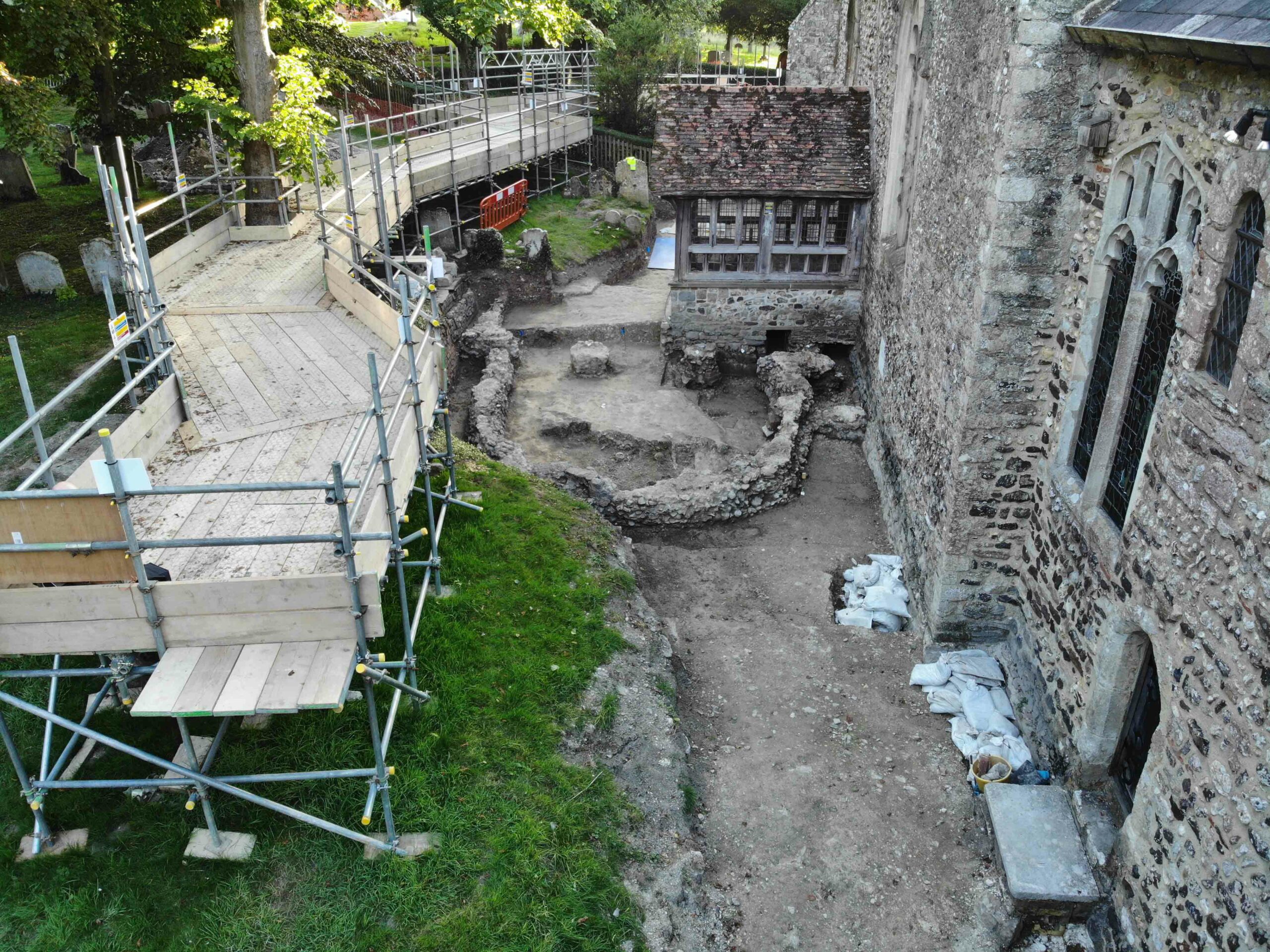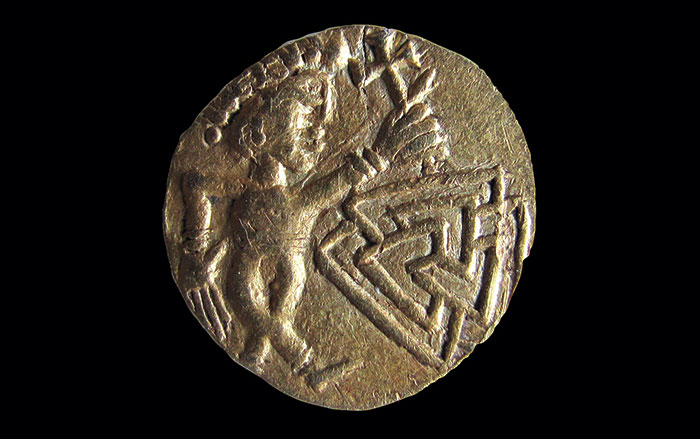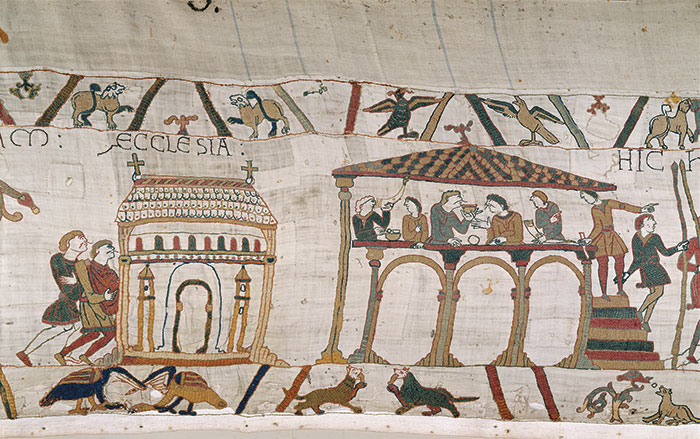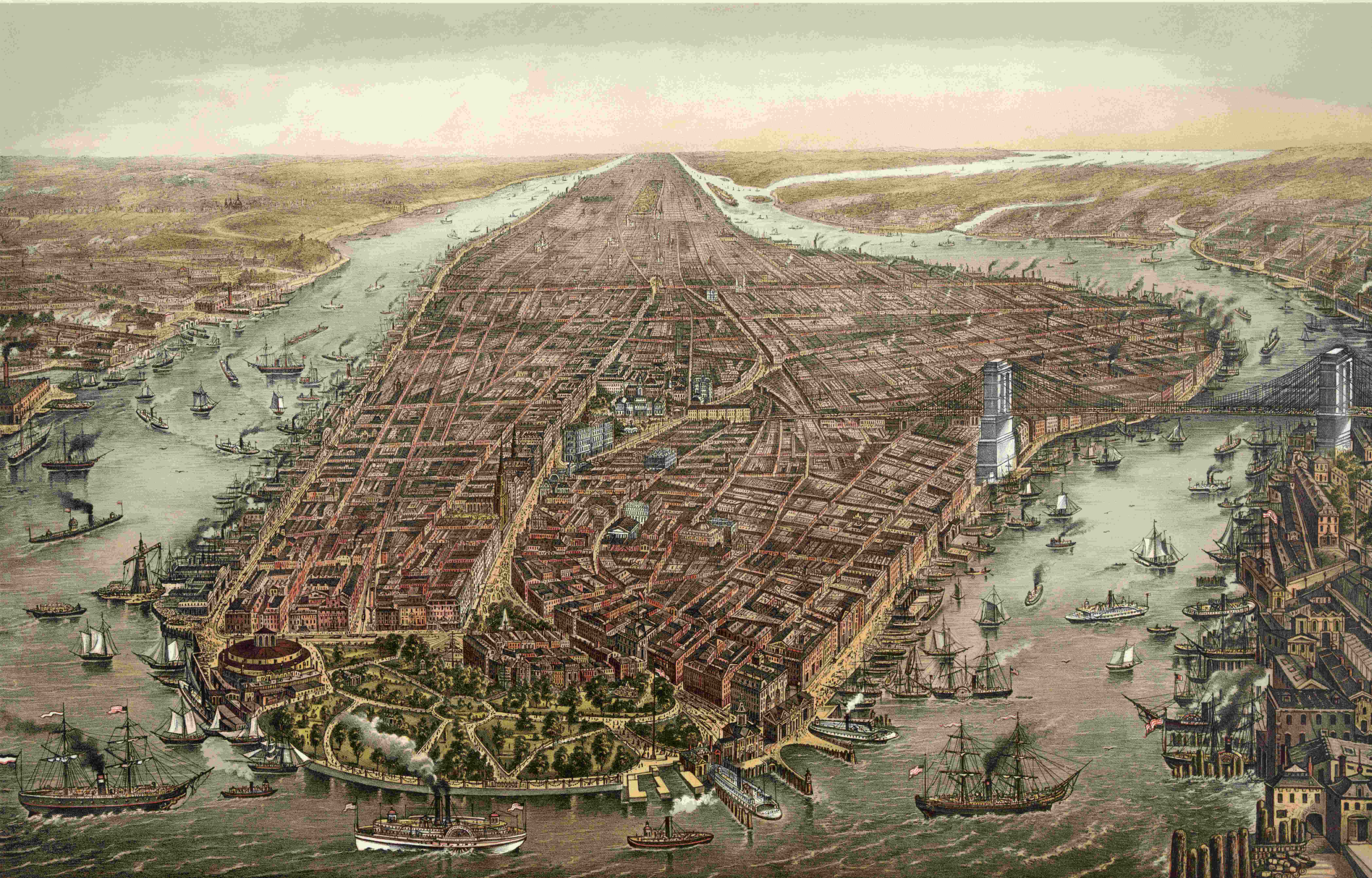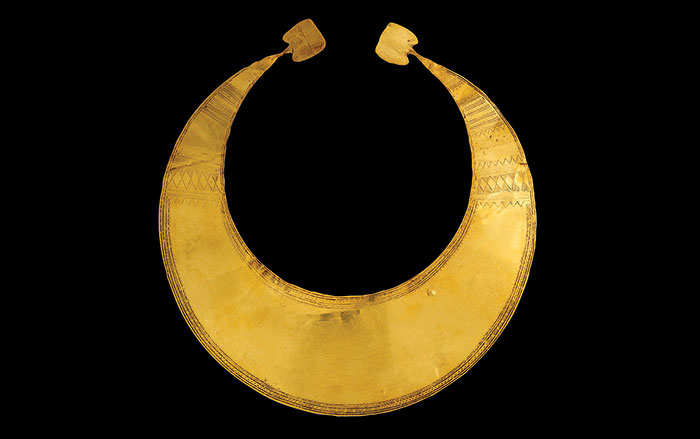
Imagine walking into your local church, pulling a penknife from your pocket, and scratching a little drawing into the wall: a geometric design, a drawing of a boat, even a few meaningful words. Today that would be sacrilege, but a new survey of the walls of medieval churches in England is revealing that many of them are covered in riots of graffiti, scratched into what were once boldly colored walls. Furthermore, the practice appears to have been condoned, and sometimes even encouraged, by Church authorities. The finds are changing the perception of how medieval worshippers viewed religion and interacted with their churches.
Cley-Next-the-Sea, on the north coast of Norfolk in eastern England, is a well-heeled tourist village of ancient flint-walled houses and narrow streets. Situated far from England’s highways, it draws visitors—but only committed ones—year-round. Its harbor silted up in the seventeenth century, so the village is now separated from the sea by spectacular salt marshes that draw many bird-watchers. But 700 years ago, Cley-Next-the-Sea was at the heart of one of the busiest ports in England, the Glaven Port, where grain, malt, fish, spices, coal, cloth, barley, and oats were exported and imported. That period of prominence explains why the seemingly insignificant village sports a glorious church of cathedralesque proportions.
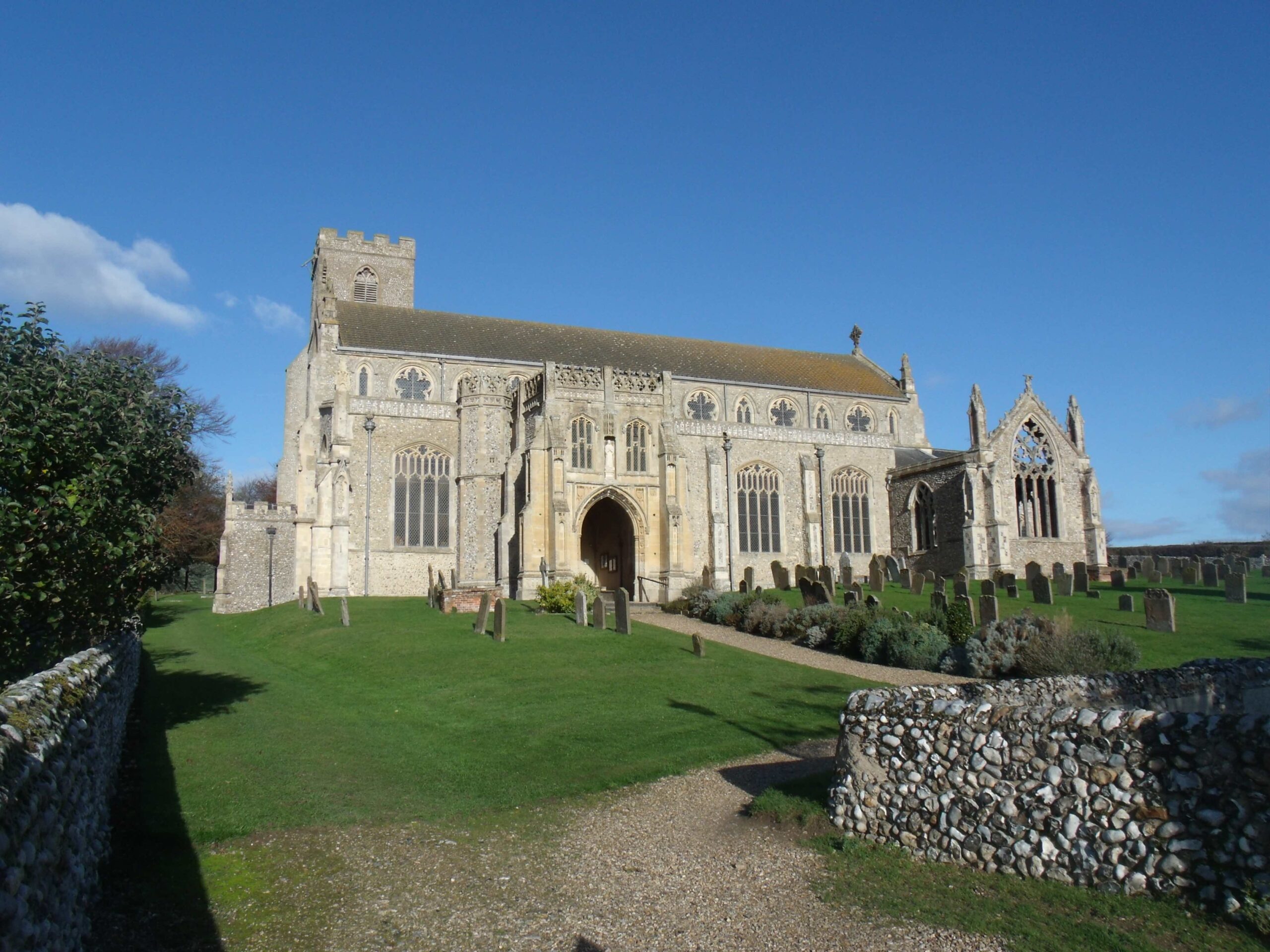
As the large wooden door shuts behind him, Matthew Champion, project director of the Norfolk and Suffolk Medieval Graffiti Surveys, proceeds to the ornate octagonal font that dominates one end of the nave of St. Margaret’s church. Its elaborately carved stone panels depict religious scenes, including a baptism and the ordination of a priest. Tiny fragments of paint in the crevices confirm that the font was brightly decorated in medieval times. “The blue color was made from lapis lazuli pigment,” Champion says, “which was very exotic and expensive then.”
Approaching what appears to be a bare patch of stone on one of the font’s panels, Champion illuminates it with his flashlight—at first from the front, and then from the side. As the panel is bathed in raking light, patterns come into view: a series of perfect circles, filled with six-petaled flower patterns, scratched into the stone.To twenty-first century eyes, the scratched designs seem incongruous with the magnificent setting, but Champion sees more than ancient graffiti. He moves quickly to the north side of the church and, this time, sweeps the beam of his flashlight down a column, where the raking light reveals repeats of this same precise geometric design. “In the past, fonts were usually situated on the north side of churches, close to the ‘Devil’s door’ [a door on the north, or ‘heathen,’ side of a church], and we find concentrations of these designs on and around the area where the font would have been,” he explains.
In 2008, Champion was asked to manage a conservation program of medieval wall paintings at Lakenheath church in Suffolk. It was when he closely inspected the paintings that he first observed marks scratched into the paint: previously unnoticed graffiti. “I was a bit nonplussed to begin with,” he says. He began to dig around in the literature and realized that no one had thoroughly documented such medieval graffiti. Perhaps this was because of its rarity, he thought. So he selected another medieval church at random—All Saints’ in Litcham, Norfolk—and inspected the walls. “I started to shine my torch and realized there were hundreds and hundreds of markings,” he says. “They are almost invisible unless you shine light on them from the side, and I think they simply hadn’t been noticed before.”
Champion was hooked, and in 2010 he started a community archaeology project, using teams of volunteers to systematically record the graffiti in the County of Norfolk’s medieval churches. With ordinary flashlights and cameras, volunteers have mapped the wall markings in half of Norfolk’s 650 or so medieval churches. To date, they have uncovered more than 28,000 inscriptions. In 2014, Champion established an equivalent survey in the neighboring County of Suffolk, with similar results. Now Champion has surveys springing up all over the country, and the findings, along with reports from other countries, suggest that medieval religious graffiti was a widespread phenomenon. “I’ve seen the same kind of symbols cropping up in churches in Norway, Germany, Spain, and even Malta,” he says. “It seems that graffiti was normal and accepted everywhere the medieval Christian Church got to.” With these data, and the promise of more, Champion has been able to provide some context and interpretation for the symbols the volunteers are finding. “Everyone from the lord of the manor to the lowliest commoner was making these marks,” says Champion.
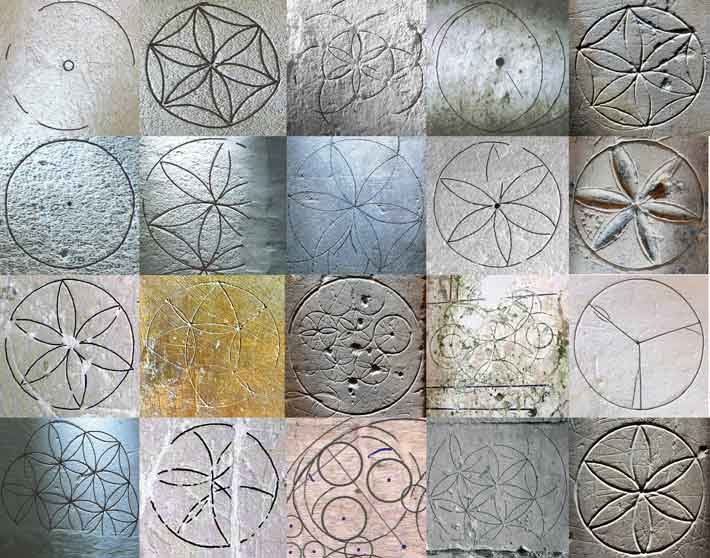
The circular floral designs, for example, turn out to be the most common motif, with several thousand recorded in Norfolk and Suffolk alone. The majority are quite small—less than four inches across—and are precise enough that they must have been drawn with compasses or other tools. “Originally, we thought these might have been created by the masons, perhaps to teach their apprentices the basics of geometry, or to create a guide for themselves,” Champion says. Indeed, some of the larger compass-drawn designs are probably exactly that, but the small designs that Champion has found peppered around fonts would have been impossible to draw with the giant compasses that masons used. Rather, the clustering of the symbol on and around fonts is a crucial clue. Traditionally, baptism ceremonies were meant to cast out the devil, and Champion thinks that the marks served as ritual protection, brought luck, and protected the person being baptized from evil. “Christianity was not the warm and fluffy religion that it is today,” he says. “People believed in the power of evil, and would do everything they could to ward off the ill forces that lurked outside the church door.” Designs like this, intricate and mazelike, were thought to trap malevolent spirits, which would follow the lines and be unable to find their way back out.
Mark Gardiner, a medieval graffiti expert from Queen’s University Belfast in Northern Ireland, agrees that the symbols were probably intended to ward off evil. “We also find an abundance of these kind of marks inside medieval houses, often close to fireplaces. This coincides with the interest in and fear of witches,” he says, “which grew markedly during the second half of the sixteenth century.”

So who could have made these marks? Compasses from this time are exceedingly rare in the archaeological record. Champion speculates that they could have been made using the little shears that women tended to carry around with them. “The shears would be about the right size, so we think it could have been predominately women making these protective symbols around the font,” he says.
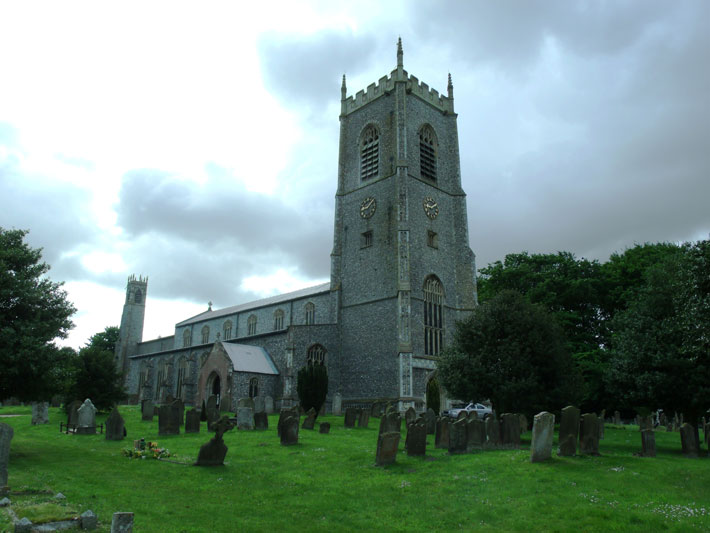
At St. Nicholas’ church in Blakeney, the village that sat at the harbor mouth of the Glaven Port, Champion squeezes past some wooden paneling to view part of a stone column normally hidden from view. Practiced in applying the right amount of raking light to make the designs emerge from the stonework, Champion flourishes his flashlight to reveal ship after ship etched at eye level and below—more than 30 in all, ranging in size from two to 12 inches. Every ship is intricately drawn, with details such as anchors, rigging, and flags. Like the font at St. Margaret’s, the column holds minuscule flecks of paint, which confirm that the ships, faint today, would have once stood out boldly on a colored background. They reflect another side of life in a medieval port—the uncertainty that comes with a culture built on the hazards of the sea. “Most of them are single-masted cogs, which were typical trading ships in the late fourteenth and early fifteenth centuries,” Champion says. By analyzing the types of ships depicted, he concluded that they were all drawn over a period of 200 to 300 years, and must have been tolerated by the priests of the day. “They could easily have repainted the column to cover them up,” he says, “but they didn’t.”
It will never be known exactly who drew the ships, but it is no accident that they are clustered around the side altar of St. Nicholas—patron saint of those in peril upon the sea. “I think they were like little prayers made solid in stone, perhaps thanks for a voyage safely undertaken, a prayer for a voyage yet to come, or maybe a plea for a ship long overdue [to return to port],” he says. According to documentary records, the Glaven Port usually had 50 to 60 ships that would have considered the harbor home, and, on average, one ship was lost at sea every two or three years. “Some of these ships were taking people on pilgrimage, and when one ship was lost, that could be as many as 250 people gone in one go,” says Champion.

Ship etchings are no surprise in a church so closely tied to the sea, but such pieces weren’t only found in coastal churches. Champion and his volunteers have found them as far inland as Leicestershire, a good 50 miles from the coast. “This inland ship graffiti is quite possibly associated with pilgrimage, with people traveling to or from continental shrines,” he explains.
The church in Steeple Bumpstead, a small village in eastern England, doesn’t have etchings of ships on its walls, but rather more stark, literal expressions of anxiety. “God help us, God help us, God help us,” reads an inscription dated 1348. “It is the scariest inscription I’ve ever seen and sends shivers down my spine,” says Champion, who documented a peak in inscriptions like this in the middle of the fourteenth century, when the Black Death swept across Europe. People were terrified of the mysterious disease, which wiped out entire villages and killed nearly half the European population over four years, and Steeple Bumpstead was particularly hard-hit. Meanwhile, in All Saints’ and St. Andrew’s in Kingston, near Cambridge, three names—Cateryn, Jane, and Amee—are inscribed, thought to belong to three children from one family who died during the 1515 plague outbreak.
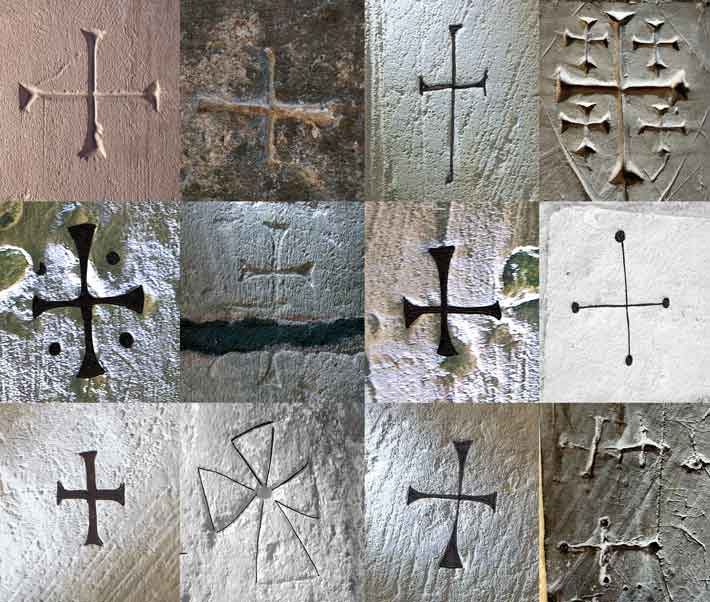
Written records clearly state that churches at the time were always locked, except during services. This reinforces the idea that the graffiti was made during Church services, condoned, and intended to be seen. “These were not the furtive scratchings of people making illicit messages, but were part of the ritualistic activity, which seems to have been quite widespread in the late Middle Ages,” Gardiner says. Indeed, some of the graffiti may have even been part of ceremonies. In many churches Champion found crosses scratched around the doors and in porch areas. “In medieval times documents and agreements were often signed in the porch, and it may have been that scratching a cross into the wall was a way of making an oath,” he says.

Another form of Church ritual—the making of donations—was the subject of still more graffiti. In Wiveton, near Blakeney, a church column sports a strange angular symbol that also appears on a crest above the “parish chest,” a huge locked trunk, located on the other side of the church, used to hold the parish’s valuables. In Wiveton, the chest had been donated by a local businessman named Raulf Greneway. Greneway’s mark was memorialized on the plaque, but then was also repeated as graffiti on the column, perhaps as a symbol of the aspirations of the family or pride at their rise in society. “This man was a working man,” explains Champion, “who had done well for himself, and the mark on his crest is a kind of heraldry or guild mark for the working man, something that was passed down through the family after he had gone. It was their way of preserving the memory of their family for posterity.” Similar merchant’s marks have turned up in the surveys across the country, though in most cases it has been impossible to trace the families to whom they belong.
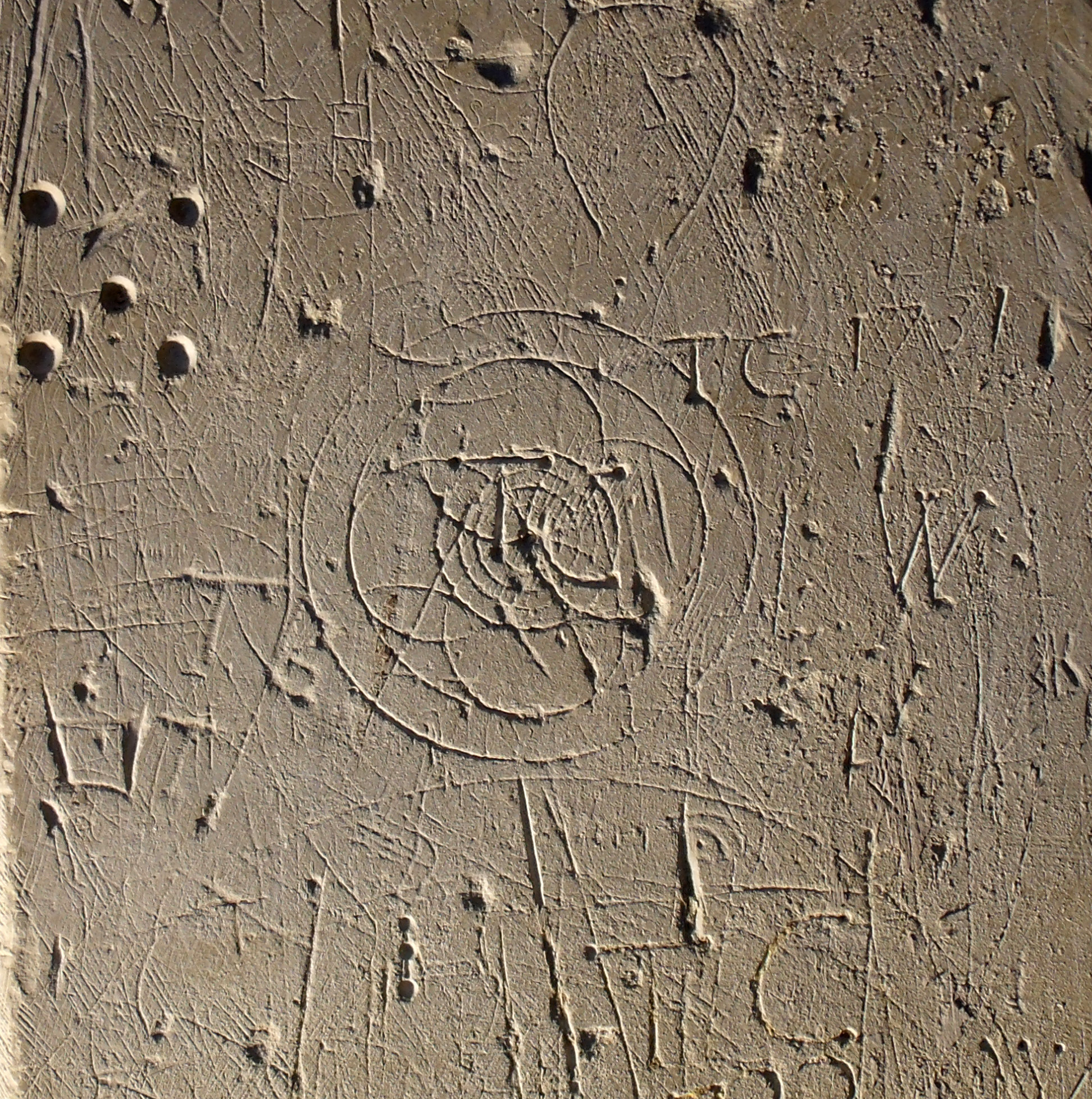
And finally, some churches sport inscriptions made by stonemasons and architects for purely functional purposes. At Binham Priory, for example, sweeping lines represent working architectural drawings dating to the 1240s. The architect in this case was experimenting with a window design from France—called bar tracery—that the English were only beginning to employ at the time. In fact, the drawings have helped settle just how the church’s large arched windows, long since collapsed, had been conceived. “It was totally revolutionary designwise,” says Champion, “and not the gradual progression in architecture we might have expected.” Taken together, all this graffiti provides Champion, his volunteers, and a visiting writer with a strong sense of connection with the people who scratched into church walls hundreds of years ago.
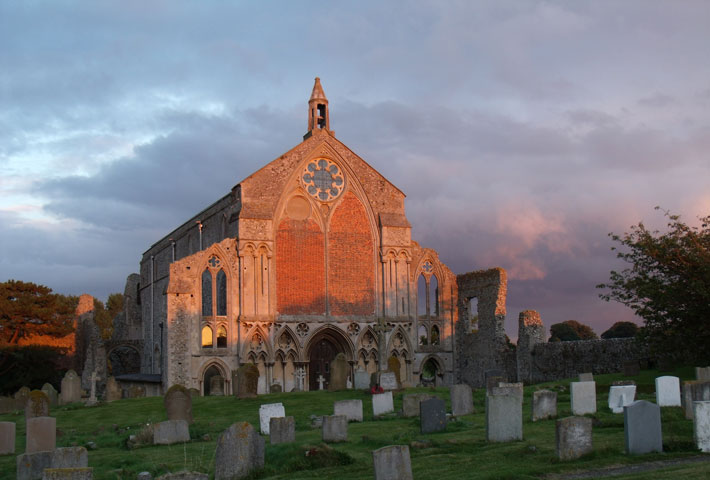
The daisy-wheel patterns from St. Margaret’s transmit an aura of fear, protectiveness, and hope for the best possible start in life. Meanwhile, the exquisite little ships at Blakeney exude excitement but also terror about the unknown. And the merchant’s marks represent the desire for a person or family to be remembered for posterity. Prior to the Protestant Reformation, which began in 1529 in England, people’s relationships with God were officially mediated via priests or the Pope. “For me, the graffiti represents the religion and spirituality of ordinary individual people,” Champion says. “It was their opportunity to communicate with God without needing the interaction of a priest.” Following the Reformation, the amount of church graffiti declines. “After the Reformation, religion became more personal—you could read your own Bible for example—so perhaps people didn’t feel the need to make their own individual mark on the church wall any more.”
At a time when writing materials were expensive and many people were illiterate, it seems that church walls were an accepted place to express one’s deepest hopes and fears.



